15 days in Guatemala
Tikal, Peten
|
The first thing I did when I landed in Guatemala was to get a plane ticket
to Tikal. The bus ride would have been long and rough, and the plane
ticket was cheap, about $30. As I was sitting at the departure gate,
I watched a guy set off the metal detector. The security guard held
out a plastic tray, and the guy plopped a huge pistol into it. He
then walked back through the metal detector, which did not go off
this time.
|

|
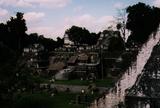
| Tikal is a set of largely-restored Mayan ruins in the middle of
the jungle. It is known for its enormous scale. There are four
main temples you can climb to get views of the surroundings.
This is the north acropolis.
|
| This is the view from Temple IV. People struggle in the
dark to get to the tops of these before sunrise.
I was lazy and arrived around 8:30. The view was of an
unending opaque whiteness, as the temples were covered in
mist. Tourists who had been there since 5 were shivering
under blankets. Around 9, the fog burned off and we could
start to see the surrounding jungle.
|

|

| Sunset is a great time to climb the temples. This is when
the tropical birds swoop through the trees, and there is
clear view to the horizon.
Here's a pisote (or coati), a cute animal that travels in huge packs.
|
Finca Ixobel
| Finca Ixobel is like a summer camp for tourists. There are
non-stop activities, like hiking or swimming through river
caves. It is easy to stay here longer than you had planned.
Especially because you have a tab, so you can really lose track
of time if you don't have to pay each day.
|
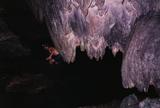
|
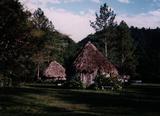
| The most picturesque accommodations at the Finca are the hammock bungalows.
They are large circular thatch-and-stick structures with a huge
central support beam, from which hammocks can be strung radially
outwards. Perhaps eight to ten hammocks can be hung in one.
If you don't have your own hammock, you can rent one. It was
the most uncomfortable hammock I have ever used. It was coarse
and made of plastic, so it was like sleeping in an onion string
bag and mosquitos quickly found me. I decided to spend my next
night in a less picturesque bed.
|
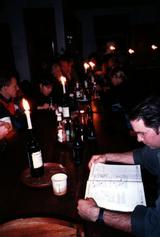
|
Dinners were communal and candlelit. It was a welcome
break from Guatemalan cuisine. Actually, the atmosphere was
suspiciously like the vegetarian coop I used to live in, down
to the long wooden dining tables and the plastic bulk bins
in the kitchen.
I actually like Guatemalan cuisine. The stews have
amazingly complex spicing. The problem is that
here, as in many parts of the world, fried and fast foods
are taking over. I couldn't speak Spanish, but it sooned
turned out that a limited vocabulary is not a problem in
most eateries. Often, if you can say pollo frito,
you could probably get the only thing they served, fried
chicken with potatoes. The fanciest-looking non-tourist
restaurant in Quetzaltenango nearly exclusively served fried chicken.
They had waiters in white shirts and black ties, and live music.
Many also consider it a treat to eat at the fast food place
because it is clean and you get really efficient service.
|
Transportation
Transportation is quite good in Guatemala. You can take
reasonably-priced first-class buses all over the country in
the dry season.
Or, if you want to be hard-core, you can take third class and
be jammed on a bus with Guatemalans and their livestock.
I actually prefered second class to either because they
weren't too crowded and the windows opened.
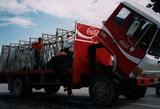
Another alternative is to hitchhike with commercial truck
drivers. When their load is empty, they are happy to take on
passengers. I was waiting for a bus outside of Finca Ixobel
with some tourists and a Guatemalan family, and one bored
tourist waved his thumb at all passing vehicles. To my
horror, a coke truck stopped. The tourist ran up to the cab,
exchanged some words with the driver, and waved for us to
climb on. The Guatemalan family looked at us like we were
crazy and did not move. We hopped on.
The ride was pretty smooth, but our driver had to periodically
top-off the radiator with creek water.
| The funny thing is that we got to our destination much faster
than the buses. We were waved by checkpoints as the police
inspected the contents of bus passenger luggage. We didn't
even slow down at the borders.
|
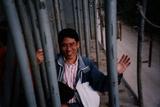
|
Livingston
| Livingston is a small town on the Caribbean accessible only by
water taxi up the Rio Dulce. It may be this isolation that
allows it to preserve its identity.
|

|
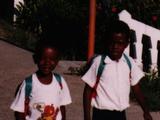
| It is completely different from the rest of Guatemala.
The people are of African and Spanish descent (not Native American),
and most people speak English. You will see signs of Bob Marley
and rasta culture throughout the town. The cuisine is also
distinct. They have fish stews with plantains (tapato)
and African dishes.
|
| The buildings are made of colorfully-painted clapboard.
The tourist facilities tend to be covered in palm thatch,
which makes for nice pictures.
The picutre is sunrise over the Caribbean from Casa Rosada,
where I stayed for a night.
It's fun to drink rum out of a coconut while sitting by the
sea.
|
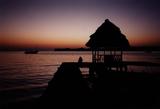
|
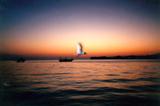
| I was talking to a baker of Chinese descent in his shop.
I asked him where he was from, and he pointed to a mattress
behind him. He added that the fortune teller told him he
would die over there, indicating another mattress by the
other end of the counter.
|
Panajachel
The stereotypical neo-hippy backpacker. You see them
all over the world and in all the liberal college towns in
the States. Their long hair and rainbow-colored clothing
and accessories usually make them stand out, but not here in
Panajachel. This
is where they make that stuff. So if you have a favorite
colorful shoulder bag, feel free to use it in public.
The old farmer walking by may be carrying the same one.
They also happen to grow pot around the lake,
so it is truly a counterculture paradise.

Lake Atitlan is a large placid lake surrounded by dormant
volcanoes. The air quality is often not good enough to
see them from Panajachel, so I was somewhat lucky to get
this shot at sunset. You can take water taxis to the
towns ringing the lake. Panajachel is by far the largest.
The other ones are more peaceful and the water may even
be clean enough to swim in. The strange thing about Atitlan
is that there is no obvious inlet or outlet - it's just a big
pool of water. Some guy in Panajachel told
me that in the late afternoon, giant whirlpools open
up in the middle of the lake. They'll tell tourists anything.
I decided not to take the afternoon ferry just in case.
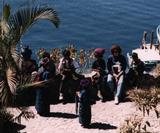
If you sit down or even pause too long in Pana, you
will immediately be surrounded by souvenir sellers.
They will offer bracelets, belts, shirts, blankets,
hackey sacks, anything. Actually, the quality is consistently
decent. The people from the surrounding villages have no
reliable source of income other than the tourist trade, so
rather than sell their goods for a pittance to a merchant,
they walk through the tourist areas trying to get cash.
You can decide if you think buying stuff from a child
is charitably giving money to the local poor instead of
the wealthy shop owners or
is encouraging children to stay out of school.
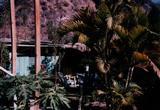
|
Hotel Santo Domingo, where I stayed for only Q15 (<$2.50)!
It was many pieces of particle board nailed together and
painted in gay Caribbean colors. However, it does have
a pleasant courtyard and a nice manager. This is where
I lay in bed with a high fever wondering why I didn't pay
the extra $3 and get a room with running water. Or at
least walls or a doorknob.
|
Sololá
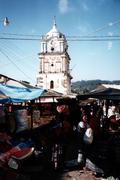
| Just up the hill from Panajachel is the town of Sololá.
It has a large market that caters to local people. Most
of the stalls sell food or household goods, and I bought
from a little stand selling textiles.
|
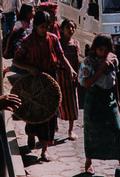
|
I realized that textile patterns are not the same all
over Guatemala. They can usually be traced to particular
cities. The scarves of Sololá are red with a distinct pattern.
All the women had these red scarves. The men
typically wore pants and shirts made of store-bought
Western-style fabrics, but the older men would wear
pants of bright embroidered fabrics.
|
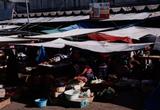
Zunil
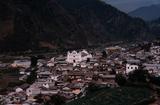
The town of Zunil is beautiful. It is in the mountainous
western part of Guatemala. The local fabrics feature a bright
purple. A good place to purchase local crafts is the cooperative,
not far from the centro mercado.
The medicinal hot springs of Fuentes Georginas are just
up the hill. Well, it is an arduous 7km walk. As I was trudging
along, a guy in a tractor offered me a lift. He dropped
me off two or three kilometers later when he had to turn off to
get to his farm, and refused to accept payment.
Fuentes Georginas was pleasant. My guidebook claimed they
were closed on Mondays, so I did not bother bringing my bathing
suit. I was surprised to see them open. I rented a voluminous
pair of orange swimming trunks and used my scarf as a towel.
The large scarf from Solola had many uses during my trip.
There are many pools of varying size and temperature, with the
more distant ones being cooler. I opted for the largest one,
which had a statue of the Virgin Mary in the middle.
The temperature varied from uncomfortably warm to pleasantly cool,
with the heat coming from distinct points in the spring floor.
A local man lounging in the spring told me that drinking the
water is good for your health. This was news to me.
He asked the guy at the refreshment
stand for a glass, and he held it under a trickle coming from
the rocky mountain and dripping into our pool. He called it
"tea" and drank it down. Well, at least this is what I think
he said. My interpretation of many things would have
been different if I had spoken Spanish. I did the same, as I was
pretty sick with diarrhea, and things couldn't get worse health-wise.
And the spring water did taste like a sour hibiscus tea.
Antigua
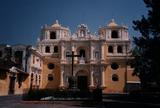
Antigua is the tourist center of Guatemala. It is a
beautiful Spanish colonial town. This is La Merced, a church.
Many of the buildings were left as ruins.
It is full of internet cafes, tourist bars, and Spanish
language schools.
It is not a particularly good place to learn Spanish, as
everyone speaks English and it is all too easy to slip into
it. Every morning, I would go to the Jugocentre Peroleto
for a bowl of yogurt (for my stomach) and fruit with honey.
They do a good job of it.
go back!




















